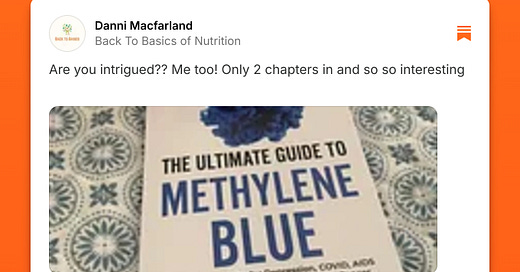Methylene Blue - Is It Another Tool In Your Health Toolbelt?
A surprise discovery that led to the world's first pharmaceutical drug and to viral debate.
Was it a coincidence that a while back I posted a NOTE on Substack’s feed on my latest book read..
Then only to hit the internet - X waves days later was RFK Jr caught putting this very thing in his water…Hmm…So what exactly is methylene blue?
The History of Methylene Blue
Methylene Blue or otherwise known as “methylthioninium chloride” is a salt that was first developed in the 19th century and was used as a fabric dye for the textile industry. It was also found to be useful in scientific labratories used as a stain to see bacteria, viruses, parasites and other microorganisms on microscope slides.
In 1880 microbiologist Robert Koch was using MB (methylene blue) to stain tuberculosis causing bacteria to understand it more. At the same time Polish pathologist Czeslaw Checinski was using it to stain malaria slides and it was actually killing the malaria parasites. In 1891 a case study was published by German physician Paul Ehrlich, whose 2 malaria patients were cured with the use of MB. This case study was used in awarding MB the title of 1st pharmaceutical drug in history. Methylene blue was given to soldiers during WWII as a preventative measure against malaria.
The World Health Organization has methylene bue on its list of essential medicines.
How Does Methylene Blue Work?
Methylene blue works in our bodies by directly increasing mitochondrial respirations. Its an oxygenator. It also benefits the body as a nitic oxide* inhibitor and estrogen antagonist (blocks or reduces the effects on estrogen). As an estrogen antagonist, MB causes an increase in thyroid function which increases your metabolic rate and overall energy production. It also aids your liver’s ability to process estrogen.
*Nitric oxide is produced naturally by the body BUT is also present in our environment in the form of industrial pollution. We tend to call these chemicals ‘free radicals’. A free radical is a molecule with an unpaired electron and is highly reactive with other chemicals and cell structures in the body. Examples of free radicals would include lead, aluminum, plastics, ionizing and non-ionizing radiation like cell phones and x-rays and chemicals that we would find in our food and personal car products.
To put it simply, free radicals are basically little chemicals monsters that go around and steal electrons off other molecules in our bodies causing damage. The good news is that we can obtain nutrients from food called antioxidants to fight off these free radicals. Antioxidants give up electrons to free radicals so that they don’t steal from our healthy cells. Methylene blue is an antioxidant.*
Methylene blue has positive effects on metabolism by
increasing oxygen consumption and ATP production
increasing glucose consumption
increasing NAD/NADH ratio
Methylene blue has positive effects on hormones by
inhibiting prolactin
inhibiting estrogen
increasing thyroid hormone and decreasing TSH
increasing testosterone
Top Benefits of Methylene Blue
The list of benefits is pretty extensive and there is more research ongoing on the benefits for many disease pathogens. But here are just a few that are worth noting.
Antidote for chemical poisonings and overdoses. Chemical poisonings induce a condition in the body called ‘methemoglobinemia’ - a blood disorder that occurs when red blood cells become oxidized and loses their capacity to carry oxygen. This disorder is caused be poisoning or overdose of cyanide, carbon monoxide, acetaminophen, pharmaceutical drugs, heavy metals, chlorine dioxide based cleaning products. Methylene blue is FDA approved to treat methemoglobinemia.
Malaria. As mentioned previously, it was given as a preventative as well as a treatment. But that was only until the drug chloroquine was developed. Did you know that hydroxychloroquine is derived from the chloroquine and methylene blue?
Covid -19 and other viruses. As found out when used to stain bacteria, viruses and parasites on laboratory slides, MB can kill these microorganisms. Methylene blue is a powerful anti-viral. In March 2020, Chinese scientists experimented with methylene blue and the effects on Covid-19 and found that MB could ‘effectively eliminate the virus in vitro within 2 minutes.’ And many other used the drug hydroxychloroquine for treatment as well (derived for methylene blue). Question is, why was this hidden from the population?? 🙄
Dementia, Alzheimer’s, Parkinson’s. Treatment and studies are being done on using MB to cure dementia, alzheimer’s and parkinson’s. In studies shown that 8-16mg daily reduced cognitive decline by more that 85% over 65 weeks! Very promising.
Depression and Manic Disorders. Methylene blue was one of the first drugs to treat psychosis at the end of the 19th century and shows positive improvements on patients with depression.
Heart Health. It is found that people with hypertension can have elevated levels of nitric oxide and with methylene blue being a nitric oxide inhibitor, this can have a promising effect on heart disease and decrease mortality rates.
Cancer. Cancer is a metabolic disease where cells have the inability to oxidize glucose in their mitochondria. Methylene blue corrects the metabolic defects by focusing on the mitochondrial function.
There is ongoing research into the benefits of MB for autism, chronic pain from surgery, neuropathic, arthritic, migraines.
Is Methylene Blue Safe?
Yes, methylene blue is a safe drug when used in therapeutic doses but can cause toxicity at high doses. It can also potentially react with SSRIs. And don’t be alarmed at your blue colored urine…It is important to use pharmaceutical grade products.
In today’s world of the high rate of metabolic diseases and the fact that methylene blue is a potent, if not the most potent metabolic therapy discovered, why wouldn’t everyone have this tool in their health toolbox??
I suggest if you want read more to pick up this book - The Ultimate Guide to Methylene Blue and get all the details, references and links to studies. I also found the information on nitic oxide very interesting and a little shocking as well.
Danni






